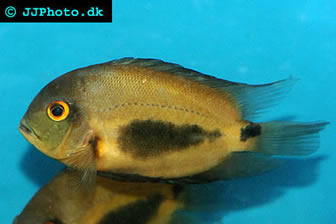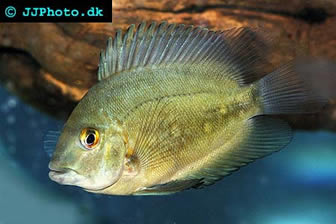Uaru – Uaru amphiacanthoides
Introduction
The genus Uaru in the cichlid family only contains two known species: Uaru amphiacanthoides and Uaru fernandezyepezi. The name Uaru is the word for toad in one of the languages spoken in the Amazon. Uaru fernandezyepezi is chiefly known as the Panda Uaru, while Uaru amphiacanthoides has several different common names, including Chocolate cichlid, Triangle cichlid, and Waroo.
In this article, we will focus on Uaru amphiacanthoides since this species is more commonly kept than Uaru fernandezyepezi. If you see a fish labelled Uaru only, it is most likely a Chocolate cichlid and not the Panda Uaru.
None of the species is a common fish among aquarists and even Uaru amphiacanthoides can be hard to find in fish stores. You will probably have to ask you local fish store to order it especially for you or try to locate a breeder yourself. It is sometimes available for sale online. If you visit Brazil, you can expect to find it in food markets since it is a popular food fish in its native region.
Before you purchase an Uaru it is advisable to examine it for spinal defects.
Uaru amphiacanthoides and Uaru fernandezyepezi are not listed on the IUCN Red List of Threatened Species.
Taxonomy
Kingdom: Animalia
Phylum: Chordata
Class: Actinopterygii
Order: Perciformes
Family: Cichlidae
Subfamily: Cichlasomatinae
Tribe: Heroini
Genus: Uaru
Species: Uaru amphiacanthoides
Geographical range, habitat and habits
Uaru amphiacanthoides lives in the upper Rio Orinoco and in the middle and lower Rio Negro basin in the Amazon basin. It inhabits both blackwaters and whitewaters and is very abundant within its native range.
It is an omnivore fish that feeds on crustaceans, worms, insects, fruits, plant matter and detritus in the wild.
Size and appearance
The largest scientifically measured Uaru amphiacanthoides was 25.0 cm (9.8 in) long. There are reports of considerably larger specimens, up to 30 cm (12 in), but Uarus larger than 25 cm (10 in) are not commonly seen.
The body of the Uaru cichlid is deep and oval disc shaped. The adult fish isn’t very spectacularly coloured outside the breeding period; it has a silvery gray colour and is decorated with a large dark brown to olive tear drop shape along the middle of the body. The teardrop is resting sideways and is pointing at the tail. At the base of the tail you can see a splotch.
During the breeding period the whole sides of the cichlid become black, leaving just a hint of brown around the edges. You can also see how the eyes change from plain and ordinary to eyes that look as if they had a coppery red flame burning inside them.
Young specimens look a bit similar to Leaf fish. They exhibit a yellow colour dotted with white. There is a dark shade near the belly which will eventually develop into the teardrop shape mentioned above. As they reach a size of roughly two inches (5 cm) the young ones begin to loose the white dots and become more like their parents.
Uaru care
The Uaru cichlid is not an aggressive fish, but it can certainly stand its ground against bullies and will violently defend its young if necessary. It is a schooling species in the wild and getting just one Uaru cichlid is therefore not a good idea. Purchasing a pair or even better a group will allow this social fish to develop its true schooling and easy going nature. A single compatible pair can be kept in a 55 gallon (200 L) aquarium and small group will normally do fine in a 100 gallon (375 L) aquarium, provided of course that you know how to keep the water quality up. If your aquarium is really large, you can house the group together with other species, such as Jack Dempsey, Heros, Geos, and Convict cichlids.
Just like many other fairly big cichlids, the Uaru is an intelligent and inquisitive creature and it can learn to recognize and respond to its keeper. It spends most of its time in the middle to bottom levels of the aquarium.
Try to resemble the Amazon environment where these fishes live when you set up the aquarium. The water should ideally be soft (5 - 12° dH) and acidic (down to pH 5.5), even though the Uaru is known to adjust to hard water and a pH-value of 7.4. It can live in temperatures down to 75° F (24° C) but 81-84° F (27-29° C) is optimal. It is very important to keep the amount of organic waste low in the aquarium. This cichlid produces quite a lot of waste so large and frequent water changes is a must. Powerful filtration (mechanical and biological) will be a great aid.
As mentioned above, it is advisable to mimic the natural environment of the Uaru cichlid when you set up the aquarium. Include a lot of hiding spots, e.g. by using plants and rocks. Ideally include driftwood in the set up since they like to chew on this. Chose a substrate without any sharp edge and use it liberally since the Uaru likes to sift through the substrate in search of food. Moderate or subdued lighting is recommended; you can for instance use floating plants to make the light milder. The Uaru loves to have densely planted areas in the aquarium but it also loves to eat plants so chose really sturdy and fast growing species. Some aquarists report that including a lot of leafy greens in the diet will make the fish less interested in destroying aquarium plants. Plastic plants or a combination of plastic and live plants is also an alternative.
Since the Uaru couple claims a territory during breeding, it is a good idea to use the aquarium décor to form natural divisions in the tank. Couples are often moved to their own separate tank for breeding purposes.
When juvenile Uaru reach a length of roughly two inches (5 cm), they change their appearance and become more like their parents. During this stage, it is perfectly normal for them to become shyer than before and spend more time hiding so don’t be alarmed if this happens.
Feeding Uaru
The Uaru is an omnivore cichlid used to a varied diet from the wild where it eats anything from crustaceans, worms and insects to plants, fruits and decaying organic matter. In the aquarium it will readily accept all kinds of food and should be kept on a diverse diet to ensure optimal health. You can for instance combine prepared foods (flakes, pellets, algae wafers etcetera) with blanched lettuce, zucchini, spinach and other greens. Also give your fish meaty foods, e.g. brine shrimp, black worms, mosquito larvae and similar. This fish will normally accept live, fresh, frozen and dried foods without much coaxing. Ideally include driftwood in the set up since they like to munch on this.
Unfortunately, the Uaru is fond of eating aquarium plants and is known to eat them down to the roots. Some aquarists report that feeding your Uaru a lot of leafy greens will make it less interested in destroying aquarium plants.
It is better to feed your Uaru 2-3 times a day instead of just one big serving.
For information about feeding Uaru fry, see the breeding section of this article.
Breeding Uaru
It is very hard to sex Uaru cichlids based on external characteristics. At full grown size the males have somewhat more pointy genital papillae than the female and they are also known to grow a bit bigger. If you wish to breed this species, the easiest method is normally to raise a group of 6-8 young fish together and let them do their own pairing.
During the breeding period the Uaru cichlid changes its rather bland everyday appearance and become black with coppery red eyes.
The female will deposit her eggs on a flat surface, such as a flat stone, a piece of slate or a flowerpot. One batch normally contains 100-400 eggs (although reports of much larger batches do exist) and the offspring are guarded by both parents. The fry hatches within 2-4 days and are then moved by their parents to a spawning pit dug out in the gravel. They stay in the pit until they become free swimming 3-4 days later.
You don’t have to feed really young Uaru fry because the parents will excrete slime from the sides of the body for the offspring to eat. In a sense, Uaru cichlids are almost like mammals. When the fry are about two weeks old you can start giving them finely powdered flake food and newly hatched brine shrimp.
When given a proper diet and kept in suitable conditions, Uaru fry grow remarkably fast. The fry are dark before developing a yellow/golden colour with white speckles. When they reach a length of roughly two inches (5 cm) they loose this speckled appearance.
Don’t loose heart if your Uaru couple eat eggs and/or fry during the first initial spawning. It is common among young parents and they will most likely get it right if you allow them to continue breeding. Leaving the lights on during the night might decrease the risk of them accidently eating their own offspring.
If they continue to fail, you can remove the fertilized eggs to a separate container but since there will be no parents to fan fresh water over them you must keep the water well aerated and add some type of anti-fungal remedy, e.g. methylene blue. It is possible for Uaru fry to survive without getting any slime from their parents.


